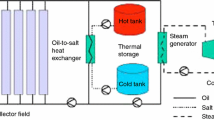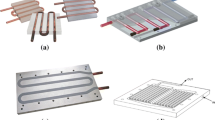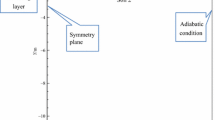Abstract
In this study, forced convection and subcooled flow boiling heat transfer coefficients of crude oil from southern oil fields of Iran were experimentally measured under different operating conditions. Despite the little data available on the heat transfer coefficient of crude oil at different operating conditions, there is an urgent need for precise and sufficient information about the status and mechanism of crude oil heat transfer for design and economic optimization of equipment such as crude oil preheaters in production units and oil refineries. The experiments were carried out in a constant heat flux heat exchanger heated by an electric heater equipped with adjustable heat flux in the range of 40–90 \({\text{kW}}\;{\text{m}}^{ - 2}\). Firstly, in order to ensure the quality of obtained data, the heat transfer coefficients of distilled water were measured and compared with the available literature data. The experimental results indicated that the heat transfer coefficient of crude oil is relatively 31% less than that of distilled water; so, the ability of crude oil in heat transfer is less than distilled water, and the temperature of the heated surface in the crude oil experiment is higher than that of distilled water. Furthermore, enhancement of fluid flow rate and heat flux increases the heat transfer coefficient. It is very difficult to distinguish the transition from forced convective heat transfer to boiling of crude oil by enhancement of heat flux. For this purpose, (Tw–Tb) was plotted against heat flux, and the obtained results indicated that the subcooled flow boiling of crude oil starts in the range of 41.9–51.3 \({\text{kW}}\;{\text{m}}^{ - 2}\). Finally, the convective heat transfer coefficients were correlated in dimensionless Nusselt form as a function of dimensionless numbers Re and Pr.












Similar content being viewed by others
Abbreviations
- \(A\) :
-
Heat transfer surface, \({\mathrm{m}}^{2}\)
- \({C}_{\mathrm{p}}\) :
-
Heat capacity, \({\text{J}}\;{\text{kg}}^{ - 1} \;{\text{K}}^{ - 1}\)
- \(d\) :
-
Diameter, \(\mathrm{m}\)
- \({d}_{\mathrm{h}}\) :
-
Hydraulic diameter, \(\mathrm{m}\)
- \(f\) :
-
Friction factor
- \(h\) :
-
Heat transfer coefficient, \({\text{W}}\;{\text{m}}^{ - 2} \;{\text{K}}^{ - 1}\)
- \(k\) :
-
Thermal conductivity of heater, \({\text{W}}\;{\text{m}}^{ - 1} \;{\text{K}}^{ - 1}\)
- \(L\) :
-
Length of heater, \(\mathrm{m}\)
- \(M\) :
-
Molecular weight, \({\text{kg}}\;{\text{kmole}}^{ - 1}\)
- m :
-
A constant in Eq. (12)
- \(\dot{m}\) :
-
Mass flow rate of fluid, \({\text{kg}}\;{\text{s}}^{ - 1}\)
- n :
-
A constant in Eq. (12)
- \(\mathrm{Nu}\) :
-
Nusselt number
- \(\mathrm{Pr}\) :
-
Prandtl number
- \(P\) :
-
Pressure, \(\mathrm{Pa}\)
- \(Q\) :
-
Volume flow rate, \({\text{m}}^{3} \;{\text{s}}^{ - 1}\)
- \(q\) :
-
Heat flux, \({\text{W}}\;{\text{m}}^{ - 2}\)
- \(\mathrm{Re}\) :
-
Reynolds number
- \(S\) :
-
Distance between thermocouple location and heat transfer surface, \(m\)
- \(T\) :
-
Temperature, \(\mathrm{K}\)
- \({T}_{\mathrm{bp}0.5}\) :
-
Temperature at 50 cumulative volume percent recovery \(\mathrm{K}\)
- \(U\) :
-
Overall heat transfer coefficient, \({\text{W}}\;{\text{m}}^{ - 2} \;{\text{K}}^{ - 1}\)
- \(V\) :
-
Fluid velocity, \({\text{m}}\;{\text{s}}^{ - 1}\)
- \(\mathrm{b}\) :
-
Bulk
- \(\mathrm{Exp}\) :
-
Experimental
- i:
-
Inside
- \(\mathrm{o}\) :
-
Outside
- \(\mathrm{max}\) :
-
Maximum
- \(\mathrm{th}\) :
-
Thermocouples
- \(\mathrm{w}\) :
-
Wall
- \(\beta\) :
-
A constant in Eq. (8)
- \(\rho\) :
-
Density, \({\text{kg}}\;{\text{m}}^{ - 3}\)
- \(\mu\) :
-
Viscosity, \({\text{kg}}\;{\text{m}}^{ - 1} \;{\text{s}}^{ - 1}\)
References
Bussman WR, Baukal CE. Ambient condition effects on process heater efficiency. Energy. 2009;34(10):1624–35. https://doi.org/10.1016/j.energy.2009.07.009.
Mostafavi SA, Rezaei A. Modeling of the fired preheater of crude oil considering the effect of geometrical parameters on fuel consumption. Heat Transf. 2022;51(2):1425–48. https://doi.org/10.1002/htj.22358.
Kundnaney ND, Kushwaha DK, editors. A critical review on heat exchangers used in oil refinery. In: 3rd Afro-Asian International Conference on Science, Engineering and Technology, Bharuch, India (2015); 2015
Shah RK, Sekulic DP. Fundamentals of heat exchanger design. Heidelberg: Wiley; 2003.
Al-Ali H. Process simulation for crude oil stabilization by using Aspen Hysys. Upstream Oil Gas Technol. 2021;7:100039. https://doi.org/10.1016/j.upstre.2021.100039.
Ishiyama EM, Pugh SJ. Considering in-tube crude oil boiling in assessing performance of preheat trains subject to fouling. Heat Trans Eng. 2015;36(7–8):632–41.
Zhang J. Optimize crude preheat train to balance efficiency and operability. Hydrocarbon Process 2013;92(6):91–6
Harris JS, Lane MR, Smith AD. Investigating the impact of boiling conditions on the fouling of a crude oil. Heat Transf Eng. 2017;38(7–8):703–11.
Gungor KE, Winterton R. A general correlation for flow boiling in tubes and annuli. Int J Heat Mass Transf. 1986;29(3):351–8.
Gungor K, Winterton RS. Simplified general correlation for saturated flow boiling and comparisons of correlations with data. Chem Eng Res Des. 1987;65(2):148–56.
Shah MM. A general correlation for heat transfer during saturated boiling with flow across tube bundles. HVAC&R Res. 2007;13(5):749–68.
Shah MM. Improved general correlation for subcooled boiling heat transfer during flow across tubes and tube bundles. HVAC&R Res. 2005;11(2):285–303.
Kandlikar SG. A general correlation for saturated two-phase flow boiling heat transfer inside horizontal and vertical tubes. 1990;112:219–28.
Kandlikar SG, Balasubramanian P. An extension of the flow boiling correlation to transition, laminar, and deep laminar flows in minichannels and microchannels. Heat Transf Eng. 2004;25(3):86–93.
Sarafraz M, Peyghambarzadeh S, Vaeli N. Subcooled flow boiling heat transfer of ethanol aqueous solutions in vertical annulus space. Chem Ind Chem Eng Q. 2012;18(2):315–27.
Peyghambarzadeh S, Sarafraz MM, Vaeli N, Ameri E, Vatani A, Jamialahmadi M. Forced convective and subcooled flow boiling heat transfer to pure water and n-heptane in an annular heat exchanger. Ann Nucl Energy. 2013;53:401–10.
Sarafraz M, Peyghambarzadeh S. Experimental study on subcooled flow boiling heat transfer to water–diethylene glycol mixtures as a coolant inside a vertical annulus. Exp Therm Fluid Sci. 2013;50:154–62.
Zangeneh A, Vatani A, Fakhroeian Z, Peyghambarzadeh S. Experimental study of forced convection and subcooled flow boiling heat transfer in a vertical annulus using different novel functionalized ZnO nanoparticles. Appl Therm Eng. 2016;109:789–802.
Abdolhossein Zadeh MA, Nakhjavani S. Subcooled flow boiling of a citric acid aqueous mixture. Arch Thermodyn. 2020;41(1):193–217.
Sarafraz M, Arya H. Convective flow boiling heat transfer in an annular space: N-heptane/water case in a bubbly sub-cooled flow. Appl Chem Eng. 2020;3(2):33–46.
Yu B, Wang Y, Zhang J, Liu X, Zhang Z, Wang K. Thermal impact of the products pipeline on the crude oil pipeline laid in one ditch–The effect of pipeline interval. Int J Heat Mass Transf. 2008;51(3–4):597–609.
Na T, Baodong C, Limin H, Qisheng C, Qi W. Research on the overall heat transfer coefficients of crude oil pipeline and product pipeline laid in one ditch. Pet Sci Technol. 2012;30(3):247–55.
Al-Rawahi MSS, Rao DG. Studies on unsteady state heat transfer to petroleum crude oil. CTAIJ. 2016;11(3):114–7.
Mohammadzaheri M, Tafreshi R, Khan Z, Franchek M, Grigoriadis K. Analytical-numerical Investigation of Factors Influencing Overall Heat Transfer Coefficient of Multiphase Petroleum Fluids in Horizontal Subsea Pipelines. Int J Petrol Sci Technol. 2017;11(1):23–33.
Noorizam NZ. Estimation & comparison of heat transfer coefficient of crude oil using various correlations: Bachelor Dissertation, Universiti Teknologi Petronas. 2011.
Deshannavar UB, Ramasamy M. A model to determine maximum heat flux under forced convective heat transfer regime for crude oil fouling studies. Appl Therm Eng. 2019;156:485–93.
ur Rehman O, Ramasamy MG, Rozali NEM, Deshannavar UB. Determination of limiting heat flux for the inception of nucleate boiling regime for crude oils. J Adv Res Fluid Mech Therm Sci. 2021;85(2):115–27.
Zhao J, Liu J, Dong H, Zhao W, Wei L. Numerical investigation on the flow and heat transfer characteristics of waxy crude oil during the tubular heating. Int J Heat Mass Transf. 2020;161:120239.
Amrouche F, Xu D, Short M, Iglauer S, Vinogradov J, Blunt MJ. Experimental study of electrical heating to enhance oil production from oil-wet carbonate reservoirs. Fuel. 2022;324:124559.
Kumar K, El Mohtar C, Gilbert R. Conductive and convective heat transfer in inductive heating of subsea buried pipelines. J Pipeline Syst Eng Pract. 2022;13(4):04022031.
Peyghambarzadeh S, Vatani A, Jamialahmadi M. Application of asymptotic model for the prediction of fouling rate of calcium sulfate under subcooled flow boiling. Appl Therm Eng. 2012;39:105–13.
Peyghambarzadeh S, Vatani A, Jamialahmadi M. Experimental study of micro-particle fouling under forced convective heat transfer. Braz J Chem Eng. 2012;29:713–24.
Vosough A, Peyghambarzadeh S, Assari M. Influence of thermal shock on the mitigation of calcium sulfate crystallization fouling under subcooled flow boiling condition. Appl Therm Eng. 2020;164:114434.
Fernández-Seara J, Uhia F, Sieres J. Laboratory practices with the Wilson plot method. Experimental Heat Transf. 2007;20(2):123–35.
Massey BS. Mechanics of Fluids. Heidelberg: Taylor; 2006.
Moffat R. Using uncertainty analysis in the planning of an experiment. Trans ASME J Fluid Eng. 1985;107:173–8.
Chen JC. Correlation for boiling heat transfer to saturated fluids in convective flow. Ind Eng Chem Process Des Dev. 1966;5(3):322–9.
ASTM D86–20b, Standard Test Method for Distillation of Petroleum Products and Liquid Fuels at Atmospheric Pressure. ASTM International. West Conshohocken, PA; 2020
Huang C-K, Lee C-W, Wang C-K. Boiling enhancement by TiO2 nanoparticle deposition. Int J Heat Mass Transf. 2011;54(23–24):4895–903.
Rana K, Rajvanshi A, Agrawal G. A visualization study of flow boiling heat transfer with nanofluids. J Visual. 2013;16(2):133–43.
Kang M-G. Effects of pool subcooling on boiling heat transfer in a vertical annulus with closed bottom. Int J Heat Mass Transf. 2005;48(2):255–63.
Sieder EN, Tate GE. Heat transfer and pressure drop of liquids in tubes. Ind Eng Chem. 1936;28(12):1429–35.
Author information
Authors and Affiliations
Corresponding author
Additional information
Publisher's Note
Springer Nature remains neutral with regard to jurisdictional claims in published maps and institutional affiliations.
Rights and permissions
Springer Nature or its licensor (e.g. a society or other partner) holds exclusive rights to this article under a publishing agreement with the author(s) or other rightsholder(s); author self-archiving of the accepted manuscript version of this article is solely governed by the terms of such publishing agreement and applicable law.
About this article
Cite this article
Majedi, S.A., Azizi, S., Peyghambarzadeh, S.M. et al. Investigation and measurement of crude oil heat transfer coefficient in forced convection and subcooled flow boiling heat transfer. J Therm Anal Calorim 148, 5805–5818 (2023). https://doi.org/10.1007/s10973-023-12065-9
Received:
Accepted:
Published:
Issue Date:
DOI: https://doi.org/10.1007/s10973-023-12065-9




